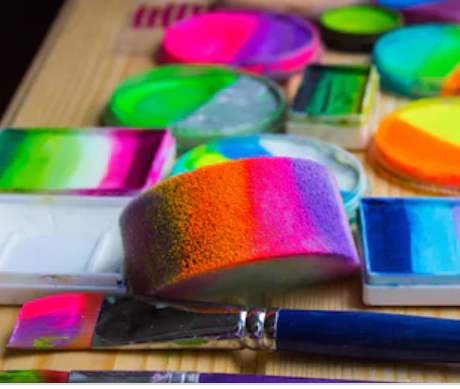Face Paint... It's good to know your products!
- Taylor-Rose
- Jan 28, 2020
- 3 min read
Body paint has been in use for a long period of time. It was used in the old days when tribesmen and women would put on paint for either rituals or wars. In modern-day, body paint has been used in many different scenarios. It’s been used in birthday parties, concerts, cosplay events and in films and theatre events.
In this industry it is important to know your product. Not all body paint is safe for the skin. It's important to identify and use the right ones to avoid irritating or damaging our skin.
There are plenty of types of face paint on the market:
1. Water-based paint: Your safest bet as far as body and face paint is concerned. Many of the water-based paints sold today are well regulated and have a strict set of guidelines that they need to follow to be cleared. It’s great to use for kids because it’s non-toxic and can be easily washed away after use.
2. Metallic body paint: Do you remember the performer on the streets that looked like a golden/silver statue? Yeah, that guy most likely used this type of body paint to achieve that shiny glossy look. Metallic body paints have the real metal powder in them mixed with a special liquid to create the “statue” effect.You should use these paints with caution as they are known to irritate the skin due to the metal powder component in them. It also doesn’t come off easily compared to water-based paint. It’s just best to avoid it unless you really need it for a performance.
3. Alcohol Based paint: This type of body paint is mostly used for special effects applications or in making airbrush tattoos. It’s best used in hot and sunny areas or for underwater body painting. Alcohol-based paints are waterproof, so sweat won’t make it crack or come off. With that said, it’s not rub-proof. It will come off when touched, so avoid doing that. Alcohol-based paints are not easy to come off and might require some rubbing alcohol to remove. You might need to wait for a day or so as you remove the paint from your skin. This gives your skin some time to rest as the rubbing alcohol might irritate it. This type of paint does have a toxic element, rubbing alcohol, so be sure to remove the body paint in a well-ventilated area to avoid harm.
4. Henna: This is the more traditional of the body paints on this list. It’s quite common in coastal African cities as well as in Asia. This body paint is extracted from plant dye and causes a brown to reddish stain when applied. It can be used for different events. For instance, it’s used as body paint for women about to get married in coastal African cities. It’s also used as skin decor by women in the same region. Henna can be used by both kids and adults with no ill effects. The body paint is temporary and tends to fade over time naturally. You can speed up the removal process by exfoliating. You should definitely avoid black henna as it contains additional chemicals that can have an ugly and allergic reaction with your skin.
5. Acrylic paint: No... To put in simply! Acrylic paint is not safe for your face. It contains harmful chemicals that can cause skin irritation and maybe even more. The paint might be a water-based solvent, but it can be a nightmare to properly wash off your skin. In fact, acrylic paint needs to be peeled off your skin which can cause even more irritation as it pulls on the tiny hairs on your face.
When it comes to face paint I always buy all my products from Australian based companies and ensure it the products are FDA approved? What does FDA mean? The Food and Drug Administration is responsible for protecting the public health by ensuring the safety, efficacy, and security of human and veterinary drugs, biological products, and medical devices; and by ensuring the safety of our nation's food supply, cosmetics, and products that emit radiation. In short, the ensure the products are safe and not full of nasties!!




Comments